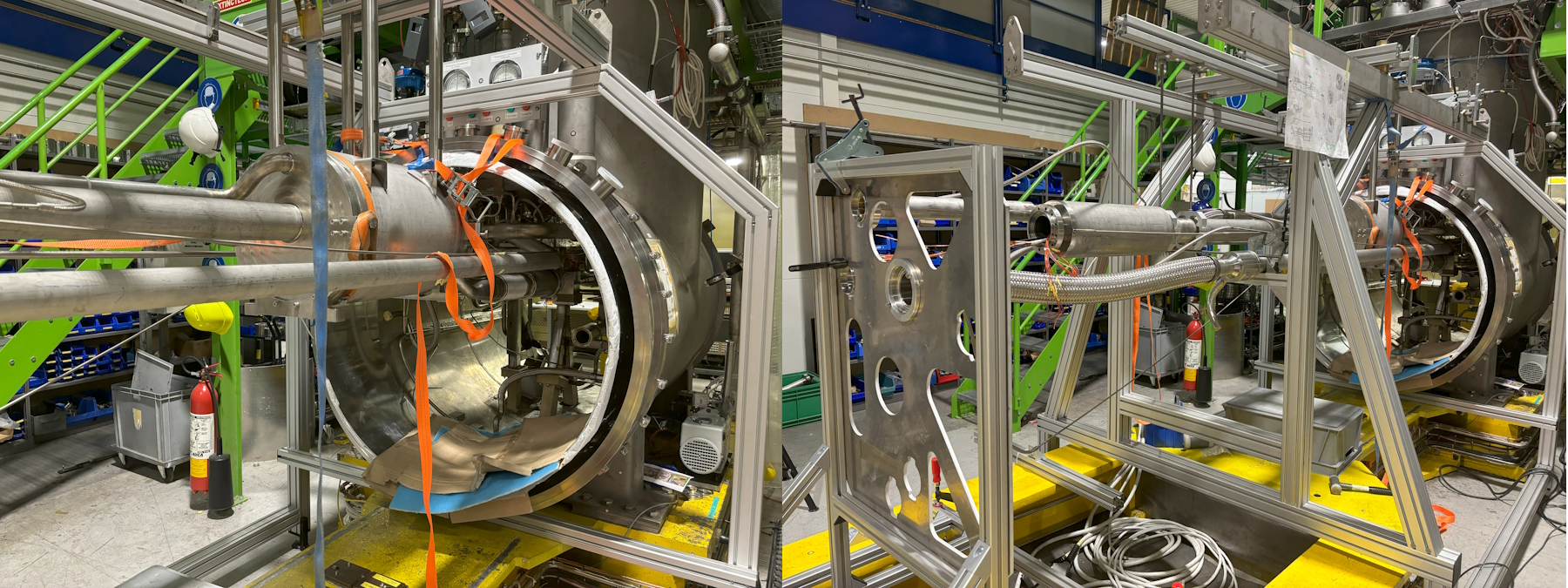By Marco Buzio, Olivier Pirotte, Frédéric Savary, Gerard Willering (CERN - TE Department)
The qualification tests of the new cryo-magnet assemblies, to ensure their compliance with the HL-LHC specifications, requires a substantial upgrade of the cryogenic test stations in SM18. Four of the ten horizontal test benches were refurbished with new mechanical, electrical and instrumentation components to make them compatible with the five types of HL-LHC cryo-magnet assemblies, while keeping other benches available for LHC spare testing. The cryo-assemblies include the world-first Nb3Sn accelerator magnets, the MQXF final-focusing quadrupoles. A fifth test bench was rebuilt to test the HL-LHC Cold Powering System (CPS) including innovative MgB2 Superconducting Link (SC-link) transporting DC currents from power converters to magnets over a length of up to 110 m. While preparation and studies of the bench upgrades have advanced in parallel with project design over many years, the upgrade was realized in the last three years thanks to the concerted efforts of more than 150 staff and contractors from the whole ATS sector (TE, BE, EN and SY departments).
In the past 18 months intense effort was put in to finalize the reconfiguration of the test benches at SM18. Today, bench F1 is already operationally used for Q2 assemblies and bench A2 for Q3 and CP assemblies. On bench F2, the first full Cold Powering Prototype System, including the MgB2 SC-Link was successfully validated. Work is now proceeding at full speed with two teams working in parallel on the assembly of the shuffling modules of benches B2 (D1 assembly) and C2 (D2 assembly), thanks to the joint effort of the TE-MSC-CMI and TE-MSC-LMF sections and TE-CRG group. At the end of 2024, all horizontal bench upgrades are foreseen to be completed to allow the testing of all types of HL-LHC magnets and Cold Powering Systems.
The upgrades include important changes to the mechanical interfaces, the powering circuits, the Cryogenic Feed Boxes (CFB) and the protection systems, including data acquisition and control systems.
The mechanics of the benches had to be adjusted to accommodate the new cryo-magnets, which have a larger magnet aperture, as well as a different arrangement of cryogenic lines. Early on, a choice was made to maintain the existing CFB, designed to test LHC type magnet assemblies. So-called Shuffling Modules are added as an extension of the CFB, containing power lines and mechanical and cryogenic connections to accommodate the new HL-LHC type magnet assemblies.


A novelty for these horizontal benches is the addition of a phase separator, installed in the M-line, allowing testing of the cryo-magnets at 4.5 K when required, and of cold pressure sensors on both sides of the magnet to follow the pressure wave in case of a quench. The cryogenic control loops of gas, liquid and superfluid Helium also had to be adapted to the large variety of operational conditions. A series of new anti-cryostats were prepared to allow magnetic measurements and quench antennas to be inserted into the new cryo-assemblies.

The ultimate current of the HL-LHC Nb3Sn quadrupole magnets is 17.5 kA, while the ultimate current of the LHC main dipole magnets is 12.84 kA. This required an upgrade of the existing power converters for powering clusters A and F, from 15 kA to 20 kA. The existing He-gas-cooled current leads in the CFB were refurbished and tested to an operation range of up to 20 kA. The nested MCBXF orbit correctors, part of the Q2 and CP cryo-assemblies, are rated 2 kA, which is significantly higher than the existing 600 A corrector circuits for the LHC. Consequently, in clusters A and F, new 2 kA power converter circuits were installed, including new energy extraction systems based on vacuum breakers. To bring the current to the magnets, a major re-cabling on the floor and on the mezzanine of the already-busy test station was required. In addition, new 2 kA current leads were designed and installed to replace the 600 A ones in the CFB of benches A2 and F1.
To interface the HL-LHC CPS with the CFB of bench F2, a simplified Shuffling Module was designed and installed.
For cluster F, configured for Q2 magnet and CPS testing, the protection system, data acquisition system and powering interlock system have been completely renewed and updated to a state-of-the-art system. It is a sophisticated two-tier interlock system with a UNICOS-based PLC system and a fast-reacting, hardware-based, matrix that - in combination - enable or disable powering according to a set of logical conditions involving hundreds of signals. Where NbTi magnets for the LHC were protected using analogue electronics as quench detection systems, Nb3Sn magnets require more intense filtering, faster detection to deal as well with phenomena such as flux-jump spikes. The Universal Quench Detection System (UQDS), developed by TE-MPE for the HL-LHC, is based on FPGA technology and also offers high-speed data acquisition. A large effort was made to create all software layers to operate, set protection thresholds, and acquire and analyse the data. With successful tests of the Q2 and CPS assemblies, the way is paved for smooth operation for use in the IT-String and the HL-LHC. Other upgrades were a new quench antenna system, which combines low-noise electronics with a pioneering spiral track-based printed-circuit board coil array that can follow the onset and propagation of a quench with high azimuthal and longitudinal resolution at the same time.
In summary, SM18 is a cryogenic test station unique in the world, and it will soon be ready to test all HL-LHC cryo-assemblies thanks to the upgrade of five of the ten LHC test benches with a new Shuffling Module. With the development and implementation of new test technologies, new power converters, new quench antenna technology, and the new protection and data acquisition systems, the versatility of the test benches and analysis has been further improved.

